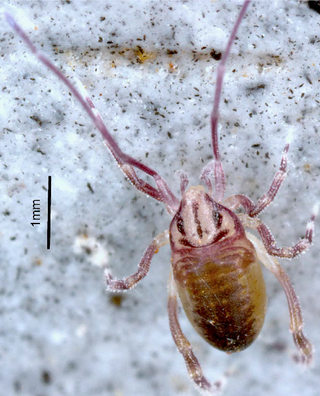Related Research Articles

Trombicula, known as chiggers, red bugs, scrub-itch mites, or berry bugs, are small arachnids in the Trombiculidae family. In their larval stage, they attach to various animals and humans, then feed on skin, often causing itching and trombiculosis. These relatives of ticks are nearly microscopic, measuring 0.4 mm (0.01 in), and have a chrome-orange hue. A common species of harvest mite in North America is Trombicula alfreddugesi.

Parasitiformes are a superorder of Arachnids, constituting one of the two major groups of mites, alongside Acariformes. Parasitiformes has, at times, been classified at the rank of order or suborder.

Opilioacaridae is the sole family of mites in the order Opilioacarida, made up of about 13 genera. The mites of this family are rare, large mites, and are widely considered primitive, as they retain six pairs of eyes, and abdominal segmentation. They have historically been considered separate from other mites belonging to Acariformes and Parasitiformes, but are now generally considered a subgroup of Parasitiformes based on molecular phylogenetics.

Mesostigmata is an order of mites belonging to the Parasitiformes. They are by far the largest group of Parasitiformes, with over 8,000 species in 130 families. Mesostigmata includes parasitic as well as free-living and predatory forms. They can be recognized by the single pair of spiracles positioned laterally on the body.
The Macronyssidae are a family of parasitic mites in the order Mesostigmata.

The Laelapidae are a family of mites in the order Mesostigmata. The family is also referred to in the literature as Laelaptidae, which may be the correct spelling.

Macrobrachium is a genus of freshwater prawns or shrimps characterised by the extreme enlargement of the second pair of pereiopods, at least in the male.
Gamasiphis is a genus of mites in the family Ologamasidae. There are more than 60 described species in Gamasiphis.
Rhodacarus is a genus of mites in the family Rhodacaridae. There are more than 20 described species in Rhodacarus.

Proctolaelaps is a genus of mites in the family Ascidae.

Zerconidae is a family of mites in the order Mesostigmata.

Heterozerconidae is a family of mites in the order Mesostigmata.

Discozerconidae is a small family of mites in the order Mesostigmata.
Sejidae is a family of mites in the order Mesostigmata. The oldest known record of the group is an indeterminate deutonymph from the mid Cretaceous (Albian-Cenomanian) aged Burmese amber of Myanmar.
Deraiophorus is a genus of mites in the order Mesostigmata, placed in its own family, Deriaphoridae.

Telenominae is a subfamily of parasitoid wasps in the family Scelionidae. It was previously considered a subfamily of Platygastridae.

Scelioninae is a subfamily of wasps in the family Scelionidae. It is a very large cosmopolitan group of exclusively parasitoid wasps, mostly small (0.5–10 mm), often black, often highly sculptured, usually with geniculate (elbowed) antennae that have a 9- or 10-segmented flagellum. It was formerly classified as a subfamily of the Platygastridae, but in 2021 the family Scelionidae was revived, containing the subfamilies Scelioninae, Teleasinae, and Telenominae.

Scaphoideini is a tribe of leafhoppers. There are 64 genera and over 600 described species in Scaphoideini.

Trigynaspida is a suborder of mites in the order Mesostigmata. There are more than 25 families and at least 90 described species in Trigynaspida.
Guntheria is a genus of mites in the family Trombiculidae. The species of this genus are found in Australia and the islands to its north.
References
- ↑ Joel Hallan (ed.). "Paramegistidae Species Listing". Biology Catalog. Texas A&M University . Retrieved September 10, 2010.
- ↑ Klompen, Hans; Austin, Christopher (2007). "A new species of Ophiomegistus Banks (Acari: Paramegistidae) from Papua New Guinea". Zootaxa. 1387: 47–57. doi:10.11646/zootaxa.1387.1.4.